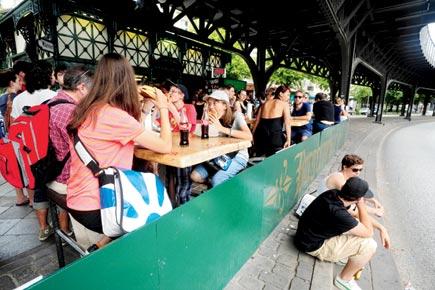The highlight of being in Berlin was wandering late into the night, tasting the culture and food, with no one to stop and question us

 Housed in a Gothic-looking structure right underneath the Metro, in what used to be a toilet, Burgermeister was teeming with Berliners. Pic/Getty Images
Housed in a Gothic-looking structure right underneath the Metro, in what used to be a toilet, Burgermeister was teeming with Berliners. Pic/Getty Images

ADVERTISEMENT
The streets were empty. We had every intention of making it to the Carnival of Cultures' parade, but we kept delaying our going there, choosing instead to first visit an unusual 'monument', one that rarely made it to traveller's itineraries because it was tucked away in Dudenstrasse. We were going to visit Hitler's Schwerbelastungskorper, which translates to “heavy load-bearing body”, essentially a ginormous concrete cylinder. This phallic enterprise had been erected between 1941-42 by Hitler's chief architect, Albert Speer, as a kind of litmus test to determine the earth's ability to bear the full thrust of the Fuhrer's dystopian urban vision - Germania. Speer needed to measure how much of the base would sink into the ground before he could go ahead with executing the grand plans Hitler had for building a massive triumphal arch on a nearby plot; three times the size of the Parisian Arc de Triomphe. It would be the centrepiece of the capital city he had in mind, a metropolis that would far outdo Berlin, a city Hitler seemed not to like very much because it didn't represent the full might of his imperial ambitions.
World War II came in the way of Hitler's architectural vision, and today, this foundation stone stands as a reminder of his idiosyncrasies. We circumambulated its circumference: 46 feet high and 21m in diameter, weighing approximately 12.65 kg per square centimetre on a 100-square-metre area. Had history gone his way, this structure would eventually be buried under an artificial hill upon which the intended arch would have been constructed. Post the war, reconstruction efforts imagined destroying this edifice, but its mass was so enormous that it could not have been successfully demolished with explosives. It stands today as a cautionary tale, I believe, to the transient nature of colonialist ambitions, a sign of forewarning about the regressiveness of self-aggrandising monuments.
After a leisurely Turkish brunch, we wandered through the city, stopping to ponder the fragments of the Berlin Wall, amazed by the stories on display of the resilience of East and West Berliners, whose sites of dwelling and whose identities were suddenly thrown in a state of crisis because of the sudden sprouting of this divisive concrete structure that zigzagged across the city almost overnight, and the many attempts at escape, some of which included tunnelling. Then we contemplated the two-kilometre stretch that is the East Side Gallery, before heading to Kreuzberg, to attend the opening of a one-night art exhibition in which my artist friend, Lisa, was participating.
Lisa was my co-resident during my time at the HH Art Spaces, and she decided to squat on the corridor of this distressed building by the River Spree, to examine and investigate the notion of home. It was after this, I imagine, that my friend and her friend walked towards the station I'm calling Schlezy, because I cannot remember its actual name. It was my friend's friend who suggested that since we were there, we pick up a bottle each of Berlin-made pale ale and grab a burger at what could have been a fairly non-descript joint, Burgermeister, which would translate to Master of Burgers. It was housed in a Gothic-looking structure right underneath the overhead Metro, in what used to be a toilet. It was teeming with Berliners, and from the look of it, you'd be hard pressed to imagine it was past midnight. It was a Sunday, but the next day was a public holiday, so Berlin was revelling. We stood in line till I placed an order for their special; a burger with a juicy beef patty and generous bits of bacon, layered with crisply sliced onion and tomatoes.
When it was ready, we picked it up and sat down on the edge of the road. In front of us was the steady stream of early morning traffic, behind us, at that junction, a heady sea of Berliners drinking on the road like they are wont to do, but with an extra hint of abandon. As I bit into my burger, it struck me that this was something I could never imagine doing back home, not just in Delhi, but anywhere in the country - sitting with wild abandon on the side of the road, past midnight, with an un-disguised bottle of excellent beer and a juicy bit of street food composed primarily of beef; unconcerned about being spotted by any authority, unapologetic about my consumptive preferences, unfettered by the issue of safety. Was this what it meant to be free?
Deliberating on the life and times of Everywoman, Rosalyn D’Mello is a reputable art critic and the author of A Handbook For My Lover. She tweets @RosaParx Send your feedback to mailbag@mid-day.com
 Subscribe today by clicking the link and stay updated with the latest news!" Click here!
Subscribe today by clicking the link and stay updated with the latest news!" Click here!







